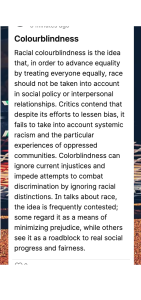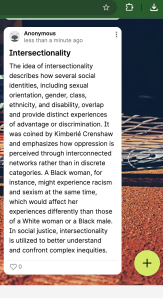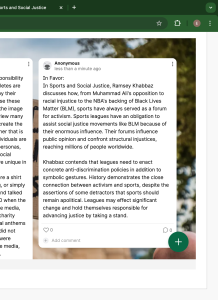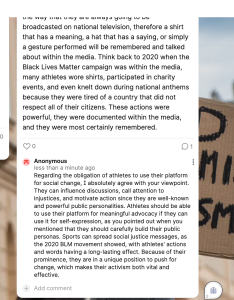3
Section One: The Fundamentals
A) Keywords
Exercise 1:
Briefly (in 100 words or less) define one of the keywords in the padlet (including one that you. may have added yourself).
| Colourblindness:
Colourblindness is the idea that, in order to advance equality by treating everyone equally, race should not be taken into account in social policy or interpersonal relationships. Critics contend that despite its efforts to lessen bias, it fails to take into account systemic racism and the particular experiences of oppressed communities. Colorblindness can ignore current injustices and impede attempts to combat discrimination by ignoring racial distinctions. In talks about race, the idea is frequently contested; some regard it as a means of minimizing prejudice, while others see it as a roadblock to real social progress and fairness. Intersectionality: The idea of intersectionality describes how several social identities, including sexual orientation, gender, class, ethnicity, and disability, overlap and provide distinct experiences of advantage or discrimination. It was coined by Kimberlé Crenshaw and emphasizes how oppression is perceived through interconnected networks rather than in discrete categories. A Black woman, for instance, might experience racism and sexism at the same time, which would affect her experiences differently than those of a White woman or a Black male. In social justice, intersectionality is utilized to better understand and confront complex inequities.
|
B) Representing Race
Exercise 2: Notebook Prompt
In about 50-70 words, consider Joel Bervell’s question: why do we feel the need to extrapolate the athleticism of one Black athlete to all Black people when we do not do the same for white athletes?
Try to think of examples when this happens, making sure to reflect on your own positionality.
| Racial stereotypes that perceive white athletes as unique while generalizing Black athleticism are brought to light by Joel Bervell’s query. Black NBA players, for instance, are frequently viewed as “naturally gifted,” whereas white players are commended for their “strategy” and “hard work.” Diversity within racial groups is disregarded by this bias. When I consider my own viewpoint, I see how the media and popular narratives influence these presumptions, highlighting structural prejudices rather than recognizing the work and talent of individuals.
|
C) Gender, Race & Sport
Exercise 3: Notebook Prompt
What are some strategies for resistance that Rajack and Joseph identify in their article as a means of pushing back against and resisting misogynoir?
| Janelle Joseph and Sabrina Razack point out a number of ways to counteract misogynoir in sports media, especially in Naomi Osaka’s representation. Self-representation is a crucial strategy, as Osaka controls her narrative on racial justice and mental health by using her platform. This resistance is strengthened by community solidarity, as her voice is amplified by marginalized groups. She and her followers may directly combat unfair coverage by using social media and challenging media narratives. Institutional advocacy also forces the media and sports leagues to confront sexism and racism. When combined, these tactics offer a potent defense against misogynoir in women’s sports.
|
Section Two: Making Connections
A) Athlete Activism
Exercise 3: Padlet Prompt
Do athletes have a responsibility to use their platform for social change? Why or why not? Please remember to record your response in both the padlet below and in your Notebook.
Athletes have a special platform that allows them to inspire societal change because of their enormous visibility, influence, and reach. Since their voices may raise awareness of significant issues and reach audiences who might not otherwise participate in action, many contend that this power entails a duty to promote justice. Athletes like Naomi Osaka, Colin Kaepernick, and Muhammad Ali have shown how sports can connect with larger social movements by using their platforms to combat racism, inequality, and the stigma associated with mental illness.
Some contend that athletes shouldn’t be required to shoulder this duty, though. They are primarily there to compete, so expecting them to get involved in activism could put them under too much pressure. Speaking up can also have hazards, such as negative reactions from sponsors, supporters, and authorities. Some people think that activists and legislators, not athletes, should be in charge of bringing about societal change.
In the end, even though it may not be mandatory, athletes who want to use their platform for social change can significantly contribute to increasing awareness and motivating action. Their advocacy has the power to confront injustices, foster discourse, and support constructive social change, so their influence goes beyond sports.
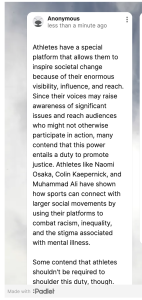
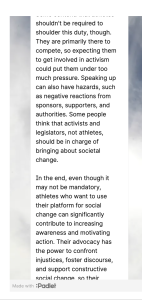
B) Athlete Activism & Feminism
Exercise 4: Complete the activities
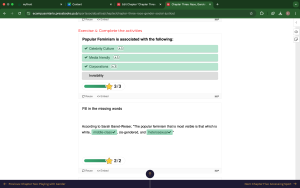
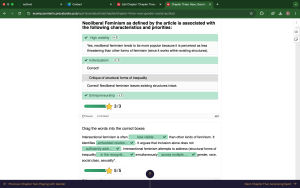
Exercise 5: Notebook Prompt
What do the authors of the article call for as a way of challenging how mainstream sports journalism privileges neoliberal feminist concerns? (100 words max.)
| According to Cooky and Antunovic, neoliberal feminism, which emphasizes personal empowerment while disregarding structural injustices, is frequently at the heart of popular sports writing. In order to recognize the systemic obstacles that women, especially women of colour, encounter in sports, they advocate for a change to intersectional feminist theory. This strategy questions media narratives that highlight personal achievement at the expense of more general problems like racism, misogyny, and institutional inequality. They promote a more inclusive and revolutionary kind of sports journalism that transcends neoliberal principles and actually helps equity in sports by amplifying collective activity and structural critiques. |
C) Corporate social justice
Exercise 6: Padlet Poll
| In Sports and Social Justice, Ramsey Khabbaz discusses how, from Muhammad Ali’s opposition to racial injustice to the NBA’s backing of Black Lives Matter (BLM), sports have always served as a forum for activism. Sports leagues have an obligation to assist social justice movements like BLM because of their enormous influence. Their forums influence public opinion and confront structural injustices, reaching millions of people worldwide.
Khabbaz contends that leagues need to enact concrete anti-discrimination policies in addition to symbolic gestures. History demonstrates the close connection between activism and sports, despite the assertions of some detractors that sports should remain apolitical. Leagues may effect significant change and hold themselves responsible for advancing justice by taking a stand.
|
Section Three: Taking a shot
Module Assignment (submit as part of notebook and separately through Blackboard mini assignment #1 portal)
The first Black athlete to play Major League Baseball in the modern age, Jackie Robinson, is compellingly portrayed in the 2013 Brian Helgeland film 42. Robinson’s portrayal in the movie draws attention to the difficulties faced by racialized athlete advocates and how they deal with discriminatory sports systems. We may better understand how sports serve as a platform for resistance and a place of exclusion by looking at Robinson’s activism tactics, the movie’s comments on his use of voice, and how race and identity shaped his portrayal.
Robinson’s practiced calm in the face of racial animosity is one of his main tactics in 42. Branch Rickey, the executive of the Brooklyn Dodgers, urged Robinson to avoid verbal reprisal, in contrast to modern athlete activists who might use social media or public demonstrations to protest injustice. At a crucial point in the movie, Robinson is subjected to racist taunts from Ben Chapman, the manager of the Philadelphia Phillies. Instead of confronting him directly, Robinson uses his aggravation to improve his performance and hits a vital home run. (Helgeland, 2013). By showing power via tenacity rather than outright conflict, this calculated stillness serves as a kind of resistance.
The film offers a nuanced assessment on Robinson’s vocal style. Even though he is frequently depicted as repressed, his activism is evident in his quiet dignity and physical performance. His deliberate act of disobedience in not responding violently to racism challenges the notion that Black athletes must confront oppressors verbally or physically in order to fight against them. The movie does, however, also recognize the emotional cost of this tactic. The internalized pain of maintaining composure is demonstrated in a devastating episode where Robinson breaks down in a tunnel following racist abuse. (Helgeland, 2013). This scene challenges the notion that passive is synonymous with silence and humanizes Robinson.
Robinson’s portrayal is heavily influenced by race and ethnicity. From the locker room to the baseball field, every part of his journey is shaped by his experiences as a Black man in a segregated world. The movie portrays him as a symbol of advancement while also highlighting how his identity makes him a target of discrimination. In contrast to white players, who are allowed to just play the game, Robinson must deal with the added pressure of demonstrating his worth and humanity.
Our perception of sports as a site of civil rights struggles is shaped by Robinson’s portrayal in 42. His on-field presence challenges an exclusive system and goes beyond baseball. This supports the claim made by Yair Galily in “‘Shut up and dribble!’? The instance of LeBron James, “Athletes Activism in the Age of Twittersphere,” examines how sports continue to be a contentious arena for advocacy. Galily draws attention to the identical pressures Robinson faced and how contemporary sportsmen, such as LeBron James, are frequently instructed to concentrate only on their athletic success rather than participate in political conversation. LeBron James and other modern-day athlete activists use their platforms, especially social media, to confront social injustices and challenge systemic racism, just like Robinson did while he played. The movie 42 supports the notion that sports activism is a continuous battle by showing how sportsmen, both past and present, must balance their political views with their professional jobs. Galily’s argument and the movie both emphasize the timeless potential of athletics as a vehicle for social transformation by comparing Robinson to contemporary individuals like James.
Galily, Y. (2019). “Shut up and dribble!”? Athletes activism in the age of twittersphere: The case of LeBron James. Technology in society, 58, 101109-. Oxford: Elsevier Ltd.
Helgeland, B. (director). (2013). 42. Warner Bros.

